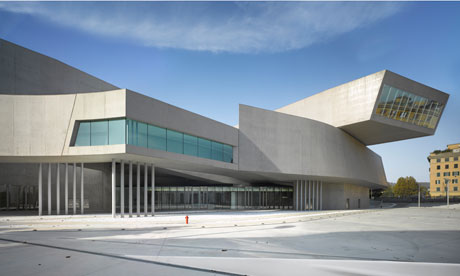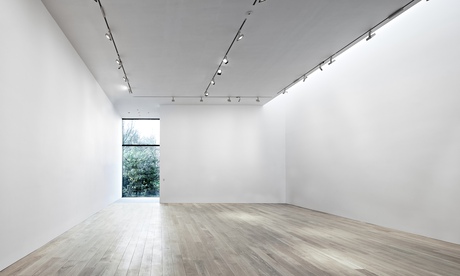How do you measure a classical church in the north-east of England, chastely converted into a community centre, against a louche re-creation in a London theatre of a Weimar republic nightclub? Or a shed for a city farm in Northern Ireland against a sumptuous bespoke guest house on a private estate? You can’t exactly. The comparison is not so much apples and oranges as blackcurrants and kumquats, souffles and chips, fish and bicycles. But to choose one from many incomparables is the challenge that faces the judges of the Stirling prize, the award given annually by the Royal Institute of British Architects to the best new building in Britain.
The 131 winners of this year’s RIBA regional awards have been announced over the past couple of weeks, from which national award winners will be chosen, from whom will come in July the shortlist for the Stirling, with the winner to be selected in October. The list offers a panorama of the current state of the more creative end of British architecture: an eclectic collection dominated by no one style or ideology, that offers varying degrees of skill, splendour and social worth. If architecture is a matter of commodity, firmness and delight, the question is how many points should be awarded in each category.
If delight is the main consideration, it’s hard to look past Saltmarsh House, a pavilion designed by last year’s Stirling winner, Níall McLaughlin, in the grounds of a Victorian faux castle on the Isle of Wight, built to do little more than contain a 12-seat dinner table, a guest bedroom, kitchen and bathroom. It’s a structure of extraordinary lightness, where a network of slender, gold-painted tubes supports a roof of shallow pyramids, copper-clad on top and ash-lined on their underside. A long wall of motorised windows can descend out of sight towards the ground, opening up the interior to the scents, sounds and views of neighbouring marshes and the sea. Timber screens are lined with hand-painted silk.
It’s mathematically insistent and precise – the diameter of the metal tubes used for both structure and light fittings is an unvarying 4cm, and it’s built to a tiny 3mm margin of error – to the point of luxuriance. Victorian greenhouses that once stood nearby are inspirations for its fragility, the Amber Fort in Jaipur for its quadripartite columns, the Japanese engawa or veranda for the open-to-nature dining room.
Saltmarsh House is beautiful but private. The Stirling prize, as it should, usually goes to projects with a clear public benefit: such as 17Nineteen, for example, where the 300-year-old Holy Trinity church in Sunderland, which historically served civic as well as religious purposes, has been made by the Newcastle architects Mosedale Gillatt into a place of folk music concerts, workshops in creative writing and historical dance, open mic nights and suchlike. It’s a calm and spare restoration that allows the old building, a light-filled volume with high Corinthian columns and big arched windows, to breathe.
The new architecture here, though, might be too reticent for the judges, in which case they could consider Lincoln Cathedral visitor centre, by the Edinburgh practice Simpson & Brown. This is a new building and a Victorian deanery converted to public use, formed around a cloister-like court, designed in the modernist-medieval, venerable-but-friendly style that the Church of England likes to deploy in the presence of its most treasured monuments, all sturdy stone piers on the exterior and emphatic timber beams within.
Or they might go for Morden College, a home for older people in Blackheath, south-east London, founded in 1695, to which the architects Mae (whose Sands End arts centre was shortlisted for last year’s Stirling) have added a brick-and-timber day care centre. It’s an intimate and informal composition, distinctly Scandinavian in spirit, lifted by moments of amplitude – a high, luminous dining space; a broad passageway winding through it; generous connections to the outside. It’s casual, you might say, except that the carefulness of the architecture is anything but.
The John Morden Centre, as Mae’s project is called, is an exemplary work of the sober, thoughtful approach that, ever since “iconic” architecture went out of favour in Britain, has tended to do well in the Stirling prize. This remains a welcome development, but it can make one yearn for a richer diet, for a bit more oomph and joy. The Creative Centre for the music and computer science courses of York St John University, by Tate + Co of London, provides some of such qualities, if a touch clumsily, with a big black projecting cube and an also-black semi-cylinder containing its auditorium, enlivened with concave and convex timber cladding. It’s also environmentally credible, with wood-based construction and simple, low-energy methods of heating and ventilation.
Another in the more-adventurous category is the East Quay Arts Centre in Watchet, Somerset, a metaphorical pile-up of things seasidey, from a cliff-like plinth to superstructures striped like beach huts, designed by Invisible Studio for the local social enterprise Onion Collective, with Ellis Williams Architects as executive architects. Reminiscent of some of the California work that Frank Gehry did before he got really famous, with intimate courts and terraces formed between its stacked-up shapes, it houses galleries, workshops and studios, a restaurant and “accommodation pods for adventurous travellers”. If sheer spectacle is your thing, there’s the transformation of the Playhouse Theatre in London by the architects Carmody Groarke and the theatre consultants Charcoalblue into an immersive, in-the-round version of the Kit Kat club that is the setting for Cabaret – all fringes and tassels in eye-shadow greens and purples, with saucy drawings on the walls in the manner of George Grosz.
But the prize, for me, should come down to two very different buildings. One is the Marshall Building for the London School of Economics, by the Dublin-based Grafton Architects: heroic, punchy and wondrously complex and wrought. No one could accuse its big, tree-like columns or sweeping spiral stair or its intersecting multistorey volumes of being too sober and retiring, but it is also considered, composed and grounded in its place and use. The only, if large, point against it is that it uses a lot of the environmentally dubious material of concrete.
The other is St James’s farm at Bog Meadows, a community resource amid the tower blocks of west Belfast, by the 10-year-old practice MMAS. It shows what might be done when you don’t have the sponsorship (as the Marshall Building does) of hedge fund wealth. Working to a minuscule budget of £212,000, the architects have designed a simple long shed, using the basic, standardised components of agricultural buildings everywhere, sited to protect a courtyard garden from road noise and fumes. It gains presence and scale from the thought with which its elements are put together – as considered in their way, if less well-resourced, than those on McLaughlin’s pavilion – and such touches as the judicious use of red paint and a run of V-shaped struts that hold up its projecting roof.
The Stirling’s judges, if the Belfast farm makes the shortlist, may think it insufficiently substantial for their weighty prize. They may also be deterred from choosing the Marshall Building on the grounds that Grafton won the prize two years ago with their Town House for Kingston University, although in previous years their predecessors were happy to honour Norman Foster, Richard Rogers and Zaha Hadid more than once. They may also be deterred by the current mistrust of concrete. It would be shame, if so, for this is architecture with a pulse.
• This article was amended on 13 June 2023 to correct the name of the executive architect for the East Quay Arts Centre, which is Ellis Williams Architects, not “William Ellis” as an earlier version said.










